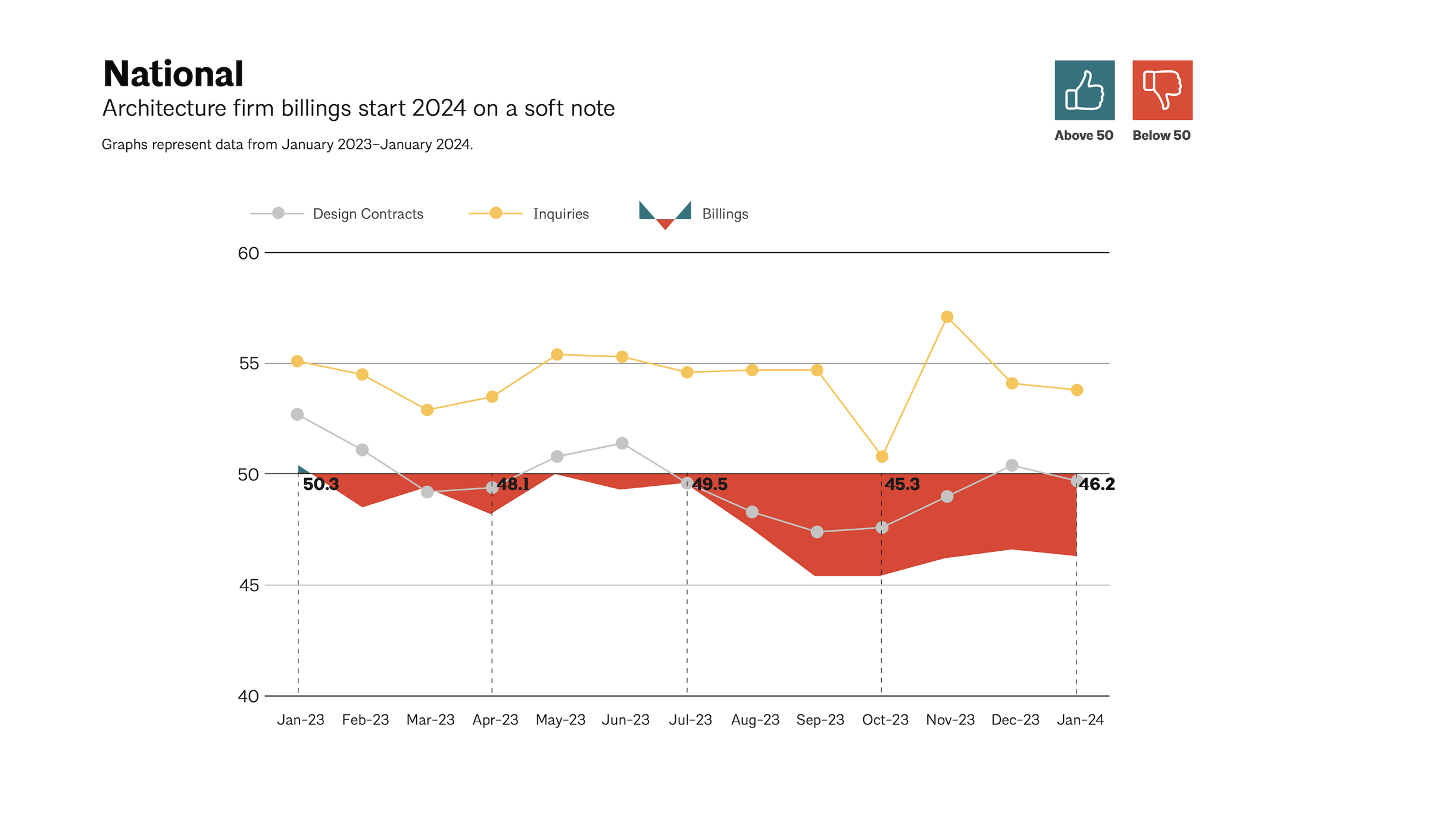Architecture firm billings remained soft entering into 2024, with an AIA/Deltek Architecture Billings Index (ABI) score of 46.2 in January. Any score below 50.0 indicates decreasing business conditions.
“This now marks the lengthiest period of declining billings since 2010, although it is reassuring that the pace of this decline is less rapid and the broader economy showed improvement in January,” said Kermit Baker, PhD, AIA Chief Economist. "Firms are seeing growth with inquiries into new projects and value of newly signed design contracts is holding steady, showing potential signs of interest from clients in new projects.”
Business conditions remained weak at firms in all regions of the country except the Midwest, where modest growth was seen in three of the last four months. Firms with a multifamily residential specialization continue to report the softest business conditions of all specializations.
The ABI score is a leading economic indicator of construction activity, providing an approximately nine-to-twelve-month glimpse into the future of nonresidential construction spending activity. The score is derived from a monthly survey of architecture firms that measures the change in the number of services provided to clients.
Key ABI highlights for January include:
- Regional averages: Northeast (43.6); Midwest (50.9); South (45.2); West (46.6)
- Sector index breakdown: commercial/industrial (47.0); institutional (48.5); mixed practice (firms that do not have at least half of their billings in any one other category) (42.9); multifamily residential (44.6)
- Project inquiries index: 53.8
- Design contracts index: 49.7
Note: The regional and sector categories are calculated as three-month moving averages and may not always average out to the national score. Every January the AIA research department updates the seasonal factors used to calculate the ABI, resulting in a revision of recent ABI values.
Related Stories
Architects | Dec 17, 2018
New toolkit helps architect achieve high-performance buildings
Architects can download a copy of the toolkit online.
Architects | Dec 13, 2018
Social media synergy: Revving up your AEC firm’s content engine
Design firms know that just having a website and a blog aren’t enough, but social media complicates how they communicate.
Architects | Dec 10, 2018
The art and science of drawing: Humanizing the design process with a bit of controlled mayhem
Hand drawing reveals a dimension beyond those available in a CAD drawing or digital rendering.
Architects | Dec 7, 2018
2019 AIA Gold Medal awarded to Lord Richard Rogers, Hon. FAIA
The Gold Medal honors an individual whose significant body of work has had a lasting influence on the theory and practice of architecture.
3D Printing | Dec 7, 2018
Additive manufacturing heads to the jobsite
Prototype mobile 3D printing shop aims to identify additive manufacturing applications for construction jobsites.
Architects | Dec 6, 2018
Payette honored with 2019 AIA Architecture Firm Award
The award recognizes a firm that has consistently produced distinguished architecture for at least 10 years.
Biophilic Design | Nov 19, 2018
Biophilic design: What is it? Why it matters? And how do we use it?
As we continue to move toward the city and spend more time indoors, our day-to-day interaction with quality nature is shrinking. One contemporary concept to reverse this effect is biophilic design, a strategic approach to tap into—and harness—nature in the built environment.
Architects | Nov 6, 2018
Kohn Pedersen Fox opens three new offices
Following exciting current work, new commissions, and upcoming opportunities, global architecture firm embraces the future with new outposts.
Architects | Oct 2, 2018
Gensler, in latest report, highlights where resilient design could make the greatest impact on the built environment
The firm showcases its own recent projects as demonstrations for what can work in six areas.
Architects | Sep 24, 2018
Assembly (and rigorous planning) required: Managing the pros and cons of modular construction
While offering efficiency and flexibility, modular construction requires extensive planning and collaboration to avoid potential challenges.















